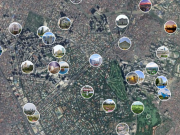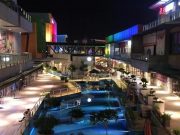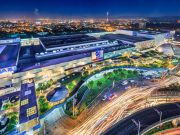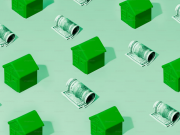Real estate developers in Metro Manila are transforming the cityscape. With their architectural marvels and innovative designs, they curate spaces that blend form and function. These spaces create thriving communities and offer endless opportunities for economic prosperity. These passionate visionaries propel the city towards a brighter and more vibrant future.
Early days of the Metro Manila Skyline
Characterized by the traditional ‘bahay kubo’ or nipa huts, the early days of the Metro Manila skyline gave way to grand cathedrals, forts, and estate houses constructed by the Spanish during their colonization. When the Americans arrived, urbanization brought neoclassical government buildings, multi-story business establishments, and improved roads and bridges. The post-war era, marked by a boom in modernist and brutalist architecture, was fuelled by strong economic growth.
From vision to reality
Real estate development is all about creating, improving, and managing properties for various purposes. It’s about bringing together professionals and making projects happen. From start to finish, real estate development covers the entire life cycle of a property, including planning, acquiring, designing, constructing, and managing. It’s a collaborative effort that takes properties from vision to reality.
Today, high-rise condominiums, office buildings, and malls have transformed Metro Manila into a major Asian metropolis. Despite these changes, the skyline still reflects the city’s rich history and the diverse influences that have shaped its development over the centuries.
Developers’ role in a nutshell
Real estate developers have the unique ability to transform ideas into profitable projects. They identify opportunities, assess market demand, navigate regulatory approvals, and oversee the development processes. Through their expertise and experience, these developers create properties that meet the needs and demands of the community while ensuring their long-term viability and desirability.
1. Project Identification and Assessment
Real estate developers identify potential projects and carefully evaluate their feasibility based on the market economy viability and long-term profitability. With a sharp eye for promising opportunities, they navigate complex landscapes to bring forth ventures that contribute to the growth and development of the real estate industry.
2. Securing Approvals
Navigating the complex process of obtaining regulatory approvals, permits, and licenses, real estate developers ensure the successful completion of the project. By handling bureaucratic requirements and ensuring compliance, they create a smooth and hassle-free implementation of the venture.
3. Project Financing
Developers secure the required financing for the project, whether this involves personal investments, bank loans, or partnerships with other stakeholders. By leveraging these diverse funding sources, developers lay a sturdy foundation for their projects while ensuring stability and sustainability in the long run.
4. Design and Construction
Real estate developers expertly oversee the design and construction process, ensuring quality and aesthetic standards. They create functional and visually appealing spaces, closely monitoring every detail to bring the envisioned outcome to life.
5. Marketing and Sales
Marketing efforts are spearheaded by developers to attract potential buyers, leveraging effective sales strategies to close deals. By actively engaging with buyers and showcasing the unique features and benefits of the property, real estate developers facilitate the seamless transition from interested prospects to satisfied homeowners.
6. Property Management
Upon the completion of construction, developers often take on the responsibility of managing the properties. It entails ensuring that they are well-maintained, meeting not only the immediate needs of the community but also taking into account any potential future requirements.
7. Community Building
With their expertise and creativity, developers contribute by designing and constructing public spaces and state-of-the-art facilities tailored to the diverse needs and aspirations of the residents. Through their innovative solutions, developers help foster inclusive and vibrant neighborhoods that enhance the quality of life for everyone.
| Real estate development has shaped cities driven by population growth, economic development, and technology. It has significantly influenced urban landscapes and contributed to the growth and prosperity of cities. |
Metro Manila Skyline Throughout the Decades
Real estate developers in Metro Manila have shaped the iconic skyline of the bustling capital. Since the 1930s, they’ve executed transformative projects, fostering community and architectural excellence. With a commitment to sustainability, they’ve left an indelible mark on the vibrant real estate scene.

1. Ortigas Center
An impressive Central Business District (CBD) that stretches over 100 hectares, Ortigas Center is within the joint boundaries of Pasig, Mandaluyong, and Quezon City. It is an area that exemplifies modern urbanism, with some of the tallest buildings in Metro Manila. Designated the flagship project of Ortigas & Company in the 1930s, it is a prominent location for offices, commercial establishments, entertainment venues, and residential towers. The Ortigas CBD’s popularity can be attributed to its convenient location and accessibility, thanks to the network of roads and highways, including EDSA, Shaw Boulevard, and Ortigas Avenue. Additionally, it is serviced by the MRT-3 Ortigas Station and Pasig River Ferry System, making it popular for businesses in industries like banking and finance, information technology, retail, and manufacturing.
2. Forbes Park Makati
A gated community that reflects the Filipinos’ preference for exclusive living, Forbes Park in the residential district of Makati City – is named after William Cameron Forbes, an American Governor-General of the Philippines. It was established in 1948 as part of Ayala Corporation’s Master Plan by Joseph McMicking. The lush landscapes and tree-lined streets offer a peaceful sanctuary from the bustling Metro Manila. Over the years, Forbes Park has become synonymous with luxury living, attracting affluent families and foreign diplomats. Its significance in the Metro Manila skyline has led to similar residential development in the country.
3. Ayala Avenue
Neilson Airfield was a significant part of Metro Manila’s history when it opened in 1937. It was a strategic location for air travel until it ceased operations in 1948. Sold to Ayala Corporation, the land and its structure were transformed into commercial and residential areas, including a two-kilometer, six-lane boulevard replacing the runway. The resulting Ayala Avenue commercial district now stretches from Epifanio de los Santos Avenue to Senator Gil Puyat Avenue (formerly Buendia Avenue) – one of the busiest and most recognizable routes in the bustling metropolis of Manila.
5. Makati Central Business District
The Makati Central Business District (CBD) is a financial hub with a fascinating history. Started by the Ayala Corporation in 1963, the commercial district of Makati City evolved from swampland into a thriving metropolis. Today, tall buildings grace its well-planned streets, highlighting the economic progress of Metro Manila. The Makati CBD is a prime example of the impactful role played by real estate development.
6. BLISS Housing Program
The Bagong Lipunan Sites and Services (BLISS) Housing Program, established in the mid-70s, provides low-cost housing in the Philippines. With support from real estate developers, the program has built 230,000 affordable housing units nationwide. Some initial projects were in Diliman in the residential district of Quezon City, Paco in Manila, Makati, Muntinlupa, Los Baños in Laguna, and San Jose in Nueva Ecija. The BLISS Housing Program was an example of government-led initiatives in various sectors.
7. SM Megamall
Opened in the 1990s, SM Mega Mall in the commercial district of Mandaluyong City is an iconic project of SM Prime Holdings, Inc., the largest shopping mall conglomerate in the country, and regarded as one of the most successful malls in Metro Manila. With its retail stores and restaurants, it has become a popular destination for shoppers.
8. Rockwell Center
A high-end mixed-use area in Poblacion Makati, Rockwell Center, developed by Rockwell Land Corporation in 1998, a company under the Lopez Group, the entire complex was once the site of a thermal power plant operated by Manila Electric Company (Meralco), the country’s leading electric distribution company. It was decommissioned in 1995 and transformed into an upscale commercial and residential district. The first residential tower, Hidalgo Place, was completed in 1999. Today, Rockwell Center is synonymous with luxurious living and a vibrant lifestyle, boasting premium residences, business establishments, educational institutions, and leisure hubs.
9. Fort Bonifacio Global City
Another remarkable project by a real estate developer is the Fort Bonifacio Global City (BGC), developed by Ayala Land in 2003 and is now one of the most sought-after locations for locals and ex-pats. Fort BGC offers a mix of residential, commercial, and recreational areas while providing world-class infrastructure to its tenants. The district also features pedestrian-friendly streets adorned with trees, parks, open spaces, and other well-maintained public facilities.
| Real estate developers have greatly influenced the skyline of Metro Manila, creating iconic projects that have shaped Metro Manila’s vibrant and livable environment. They are essential partners in the city’s urbanization, contributing to its sustainability and future growth. |
Innovative strategies
Real estate developers push innovation boundaries with revolutionized designs, cutting-edge technologies, and sustainable approaches. Learn about their approach to reshaping the built environment in this article.
1. Utilization of Vertical Space
Real estate developers, in response to the scarcity of land, have strategically embraced the upward building approach. This innovative strategy has led to the construction of towering high-rise residential and commercial buildings that adorn the city skyline. These architectural marvels have not only maximized land utilization but have also become iconic symbols of modern urban development, showcasing the ingenuity and vision of these developers.
2. Adoption of Sustainable Practices
In recent years, developers have taken significant strides in integrating sustainable features into their projects. These include adding green spaces to promote biodiversity, implementing energy-efficient designs to reduce carbon footprint, and incorporating advanced waste management systems to minimize environmental impact. These efforts not only enhance the aesthetic appeal of the skyline but also have a profound positive effect on long-term sustainability. By prioritizing these sustainable practices, developers contribute to a greener and more sustainable future for our cities.
3. Integration of Mixed-Use Developments
Metro Manila’s developers have embraced mixed-use developments, seamlessly integrating residential, commercial, and leisure spaces. These projects revolutionize city living, offering convenience, vibrant communities, and well-rounded lifestyles. With a focus on sustainability, they are shaping the future of urban environments.
4. Incorporation of Cultural Elements
Respecting and preserving the city’s cultural heritage, developers often incorporate local architectural styles and elements into their designs. This strategy adds a unique and distinctive character to the skyline.
5. Embrace Technological Innovations
With the latest advancements in construction and design, developers have created innovative structures, pushing boundaries and leaving an indelible mark on the Metro Manila skyline. Their creativity and attention to detail continue to shape the cityscape.
| Real estate developers shape the Metro Manila skyline, drive economic growth, and create employment opportunities through investments and urban development projects. Responsible and sustainable practices are essential for long-term growth and livability, balancing heritage preservation with modernization to create a cityscape that meets the needs of its residents while retaining its unique identity. |
To shape the future of the Metro Manila Skyline, developers need to embrace new trends, technologies, and sustainable practices while adapting to ever-evolving changes. This continuous transformation is crucial in creating a skyline that reflects innovation and sustainability.

























